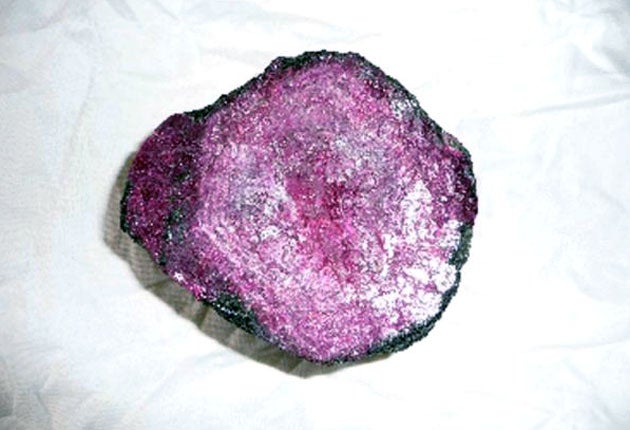The '£11m Gem of Tanzania' exposed as a £100 fake

Your support helps us to tell the story
From reproductive rights to climate change to Big Tech, The Independent is on the ground when the story is developing. Whether it's investigating the financials of Elon Musk's pro-Trump PAC or producing our latest documentary, 'The A Word', which shines a light on the American women fighting for reproductive rights, we know how important it is to parse out the facts from the messaging.
At such a critical moment in US history, we need reporters on the ground. Your donation allows us to keep sending journalists to speak to both sides of the story.
The Independent is trusted by Americans across the entire political spectrum. And unlike many other quality news outlets, we choose not to lock Americans out of our reporting and analysis with paywalls. We believe quality journalism should be available to everyone, paid for by those who can afford it.
Your support makes all the difference.It was once thought to be the most valuable jewel of its kind in the world, an enormous uncut ruby worth £11m with a history so murky that one of its former owners declared it to be cursed.
Now, the so-called "Gem of Tanzania" – which once famously appeared as the principal asset on the balance sheet of a bankrupt Shropshire construction company – has been revealed to be little more than an expensive paperweight. The 2.1kg (4.6lb) rock is now believed to be a large lump of anyolite, a low-grade form of ruby, with a value of just £100.
Administrators for its owners, the now-defunct Wrekin Construction, have reportedly given up their attempts to interest London's prestigious auction houses in the jewel, and plan to list it for sale in Rock 'n' Gem, a quarterly magazine aimed at mineral collectors.
David Unwin, a Derbyshire businessman, acquired the gem from a Cheshire property developer called Tony Haworth as part of a land deal in 2007. Valuation documents at the time stated that it was worth £300,000 – but when Mr Unwin's company Wrekin Construction collapsed in March, its accounts listed the gem as its biggest asset at £11m.
Marcus McCallum, a jewel dealer from Hatton Garden in London, told the Financial Times that even the £300,000 figure was a far cry from the stone's probable value. "The Gem of Tanzania may not be worth the cost of the advert," he said. "A two kilo lump of anyolite is probably worth about £100. A valuation of £11m would be utterly bonkers."
Wrekin's administrators, Ernst & Young, have included the gem in a lot of the company's former office equipment being sold over the internet, where it appears in bizarre juxtaposition to a collection of telephones, swivel chairs, old printers and laminate desks. However, a buyer is also being sought through adverts in magazines.
"The joint administrators are seeking to maximise realisations from the Gem of Tanzania for the benefit of the creditors," said Ian Best of Ernst & Young. "The gem will be widely advertised in specialist publications by our agents, GVA Grimley Limited, and details of the sale have been circulated to all of Wrekin's creditors and appropriate media."
The gem was discovered in 2002 by a mining company carrying out excavations in northern Tanzania. A South African businessman, Trevor Michael Hart-Jones, bought it for £13,000. It next appeared in the possession of Mr Haworth, who sold it to Mr Unwin.
Mr Hart-Jones has since claimed that it is "jinxed" – hardly a ringing endorsement for a gem which has already had its fair share of bad publicity.
Join our commenting forum
Join thought-provoking conversations, follow other Independent readers and see their replies
Comments